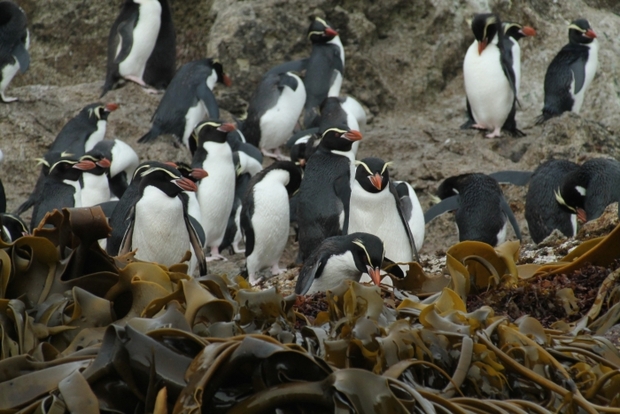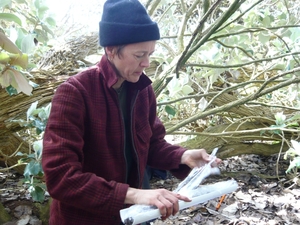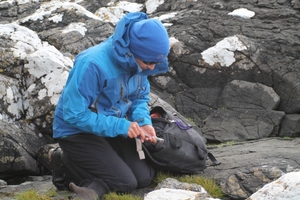
Snares crested penguins, which are endemic to the Snares islands, gather in their hundreds along the rugged shoreline. (all images: V Meduna)
Windswept and isolated, New Zealand’s subantarctic islands are tiny specks of land in the middle of the Southern Ocean, but they provide vital breeding grounds for rare seabirds and marine mammals.
The vast subantarctic ocean stretches in a circumpolar belt between the latitudes of 40 and 60 degrees South. In total, there are 18 widely scattered archipelagos, which are all claimed and administered by a number of nations. New Zealand has the most extensive subantarctic portfolio with five island groups: the Snares, Auckland Islands, the southern-most Campbell Island, the Bounties and Antipodes.
These islands are National Nature Reserves, the highest possible conservation status possible under New Zealand legislation, as well as World Heritage sites. Recently an international study ranked them among 80 sites worldwide whose value as wildlife sanctuaries is considered irreplaceable.
While they play an important role in the Southern Ocean ecosystem, they also have a rich human history of sealing and whaling, and several failed settlement attempts. In December, research teams from New Zealand and Australia travelled south during the first leg of the Australasian Antarctic Expedition 2013/14 to explore this region. This radio programme focuses on the science projects carried out during the voyage, but for more background and a daily account, you can also read the blog.
Palaeo Ecology
The subantarctic islands provide the only terrestrial record for a vast area of the Southern Ocean, which makes them ideal field sites for the study of vegetation changes in response to past climates or human impact. A team of ecologists from Landcare Research (Matt McGlone, Sarah Richardson and Janet Wilmshurst) and dendro-climatologist Jonathan Palmer conducted plant surveys, extracted peat cores, collected samples of surface litter and analysed tree rings from vegetation plots on several islands to gather information about the island’s botanical history and response to the temporary presence of humans and introduced mammals.
 Janet Wilmshurst (left, pictured on Ewing Island) and Sarah Richardson collected peat cores from the Snares islands, which represent the first samples since Sir Charles Fleming analysed the islands’ pollen records in the early 1950s, before radiocarbon dating methods were available. Pollen and charcoal records in cores collected on Enderby Island, within the Auckland Island group, track the impact of human settlement going back 700 years when Polynesian navigators are thought to have visited the island at about the same time as they settled in New Zealand.
Janet Wilmshurst (left, pictured on Ewing Island) and Sarah Richardson collected peat cores from the Snares islands, which represent the first samples since Sir Charles Fleming analysed the islands’ pollen records in the early 1950s, before radiocarbon dating methods were available. Pollen and charcoal records in cores collected on Enderby Island, within the Auckland Island group, track the impact of human settlement going back 700 years when Polynesian navigators are thought to have visited the island at about the same time as they settled in New Zealand.
Biological Diversity
New Zealand’s subantarctic islands have been described as the world’s seabird capital. More than 40 seabird species, at least 11 per cent of the world’s seabirds, breed in the region and more than 120 species have been observed on the islands or in the surrounding ocean. They include albatrosses and their smaller cousins, the mollymawks, petrels, shearwaters, fulmars, prions and penguins. Ten of the world’s albatross species, some 40 per cent, breed in the region, six of them nowhere else. In this programme, you can join ornithologist Kerry-Jayne Wilson during birding expeditions to rarely-visited smaller islands, where she looked for burrow-breeding seabirds. You can also listen to earlier Our Changing World programmes about Gibson's and Antipodes wandering albatrosses and yellow-eyed penguins on the Auckland Islands.

 While seabirds and members of the seal family (such as the two New Zealand sea lions above) dominate the subantarctic island fauna, there are also several land birds and invertebrates. During this voyage, University of Otago zoologist Rebecca Cummings (left) went in search of terrestrial populations of slugs that belong to the predominantly marine genus Onchidella.
While seabirds and members of the seal family (such as the two New Zealand sea lions above) dominate the subantarctic island fauna, there are also several land birds and invertebrates. During this voyage, University of Otago zoologist Rebecca Cummings (left) went in search of terrestrial populations of slugs that belong to the predominantly marine genus Onchidella.
A single population of a terrestrial species has been discovered on an island off the Otago coast, and Rebecca discovered several specimens on Enderby Island. She reports that subsequent genetic analysis suggests that these southern terrestrials are a new genus, possibly endemic to New Zealand’s southern regions, but that each subantarctic island may have its own distinct species. How they colonised these islands remains a mystery.
Underwater World

University of New South Wales marine ecologists Emma Johnston and Graeme Clark (above) set out to explore the region’s seafloor with the help of baited remote underwater video stations (BRUVs), while glacial geologist Chris Fogwill conducted a multibeam sonar scan of Carnley Harbour.
Antarctic Leg of Australasian Antarctic Expedition

This subantarctic voyage was the first leg of the Australasian Antarctic Expedition 2013/14 aboard the Akademik Shokalskiy (images from onboard ship above), leg by University of New South Wales earth scientist Chris Turney and glacial geologist Chris Fogwill. During leg 2, which traced the voyage of Australian explorer Sir Douglas Mawson a century ago, about half of the expedition members were paying passengers, who assisted with the research projects. The expedition made headlines when the Shokalskiy got stuck in Antarctic sea ice on Christmas Day, while visiting the Hogheman Islands, a cluster of rocky isles that rise from the fast ice near the east Antarctic shore. The Shokalskiy’s location was near the Mertz Glacier, which lost the tip of its tongue four years ago when a massive iceberg called B09B rammed into it.
When the ship’s captain made a mayday call, the Australian Maritime Rescue Coordination Centre diverted the nearest vessels to attempt a rescue. The first ship to arrive was the Chinese icebreaker Xue Long, but it too got stuck. Weather conditions delayed further attempts for several days, until on 2 January 2014, all passengers and expedition staff were airlifted by helicopters from the Xue Long onto the Australian icebreaker Aurora Australis, which was on its way to supply the Australian Casey station.
The Guardian and the BBC had journalists on board who covered both the science projects carried out during the expedition and the rescue itself. You can read the Guardian’s coverage and listen to the BBC’s Discovery programmes, but the BBC’s Andrew Luck-Baker later also published this account of how and why the Shokalskiy became trapped. We will follow up on the issues this raised about combining Antarctic research with tourism in a future programme.

